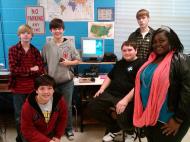Amateur Radio In The Classroom & Beyond ...
Here are a variety of articles that describe the classroom activities of students who are on the air with Amateur Radio – these activities include studying weather, building and programming robots, launching balloons and transmitting telemetry data, and learning about wireless technology through Amateur Radio – using resources provided by ARRL's Education & Technology Program.
LASA High School Amateur Radio Club, K5LBJ Build A Satellite Station
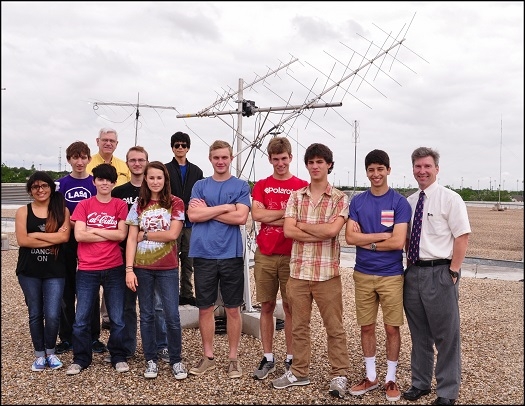
From a basic amateur radio station provided by the ARRL Education & Technology Program to the construction of a satellite tracking/communcation station, students in the Amateur Radio Club at Liberal Arts & Science Acdemy in Austin,Texas have experience with a full menu of Amateur Radio modes. Now in its 10th year, the club has added satellite communciations capability.
Read more about their progress and their recent successes contacting the ISS and downloading SSTV images in the June 2015 article published in QST.
Listen to an audio recording of K5LBJ working stations via amateur satellite SO-50.
Ham Radio Becomes an Integral Part of High School Curriculum in Chesapeake Virginia
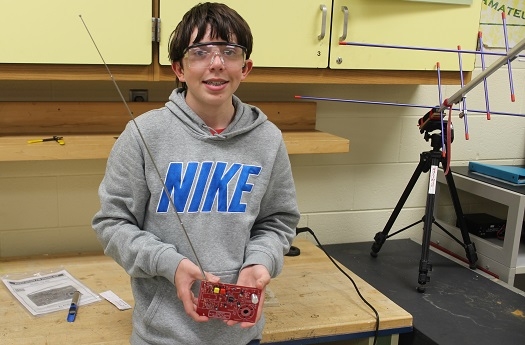
Amateur Radio has become an official part of this school system’s STEM (Science,Technology, Engineering, and Math) coursework. Career and Technical Education (CTE) teacher, John Bowser, W4RMY, developed a curriculum for his high school’s electronics classes that incorporates Amateur Radio concepts and hands-on experience. In the photo, an Electroncis I student shows off the FM radio he built. Read more.
-
Ham Radio A Source for Project Based Learning at Dorothy Grant Elementary School
Fourth and fifth grade teacher, Beverly Matheson teaches 30 eager students electronics and radio science. Read more about the school's club activities and student learning opportunities.
-
St. Charles High School Students Rediscover Ham Radio
St. Charles High School teacher Ellen Zerr, KD0PES, participated in ARRL's Teachers Institute on Wireless Technology in July 2011, and received a grant from ARRL's Education& Technology Program for an Amaterur Radio station in 2012. Now fox hunts, emergency communications, and radio science are on the learning agenda.
Learn More -
Olde Towne Middle School Conducts Research via Near-Space Balloon
March 5, 2012- "I just wanted to let you know some of the basics about the balloon flight last Saturday. Here are a few brief snip-its:
- LEO-1 was the flight name. It went really long! Landed in a fighting-bull farm in Ashville, Alabama. Landed in a 100 foot pine tree on the edge of a field... in the friendly bull pasture.
- All experiments were accounted for, and we duplicated a very strange one from last year that no scientist has been able to verify what caused it. All other experiences are being worked on, and the local Medical School is going to help us look at the bacteria experiments we ran.
- Over 1000 pictures were taken.
- We might be in the record book for VHF telemetry! More on that when it is confirmed.
- Max Altitude 97,000 feet.
Attached is a doc from the Science Teacher, Bobby Robinson. He is in charge of all science projects. My radio club is in charge of piloting and assembly of the delivery method - the balloon."
List of science research projects on board LEO-1
Bill Richardson, N5VEIOlde Towne Middle School
Ridgeland, Mississippi
Read about the school's maiden balloon launch in 2010...
Pictured are a group of students standing around a computer set up inside.
Learn More - LEO-1 was the flight name. It went really long! Landed in a fighting-bull farm in Ashville, Alabama. Landed in a 100 foot pine tree on the edge of a field... in the friendly bull pasture.
-
Cherry Creek Students Talk to the World and to the ISS
July 15, 2011- "After attending the summer TI session in ABQ I, with the help of Bryon 'Paul' Veal, taught 2 weeks of Wireless Technology classes in Aurora, CO. The local paper ran the attached story after hearing about the class.
Many thanks to Miguel and Tommy for showing me how to "Light the Spark" with these young people. We now have at least 16 students actively working on getting licensed. We will have a technician class in September for those who need more formal instruction. One of our students even made a CW contact in Belgium after only 2 days in class.
Thanks again.
--
Bob Sterner KNØBOBOctober 28, 2011- "We had our "Wireless Technology" week over Fall Break. Our enrollment was 17 students (4th - 7th) grade. We were able to teach the students about the Boe-bots wireless technology as well as CW and "Tape-Measure Yagi's".
We had SSB contact with Christmas Island as well as several stations in Europe. We worked AO-27 and even got a couple of calls on VO-51 QRP. Several of the students would like to move on to get their license. We have a Tech License class in November.
Below are two links to the audio contact our group made with the ISS."
http://www.nasa.gov/mission_pages/station/expeditions/expedition29/exp29_ham.html
http://www.youtube.com/watch?v=qNflnuDlfhM
--
Bob Sterner KNØBOB -
Sun Shines on the Granite Bay Montessori Shack
Students designed a solar power system for their station.
Learn More -
Alabama High Schools Successfully Launch High Altitude Balloon
April 2011 - The balloon was launched from the St Clair County Airport in Pell City, Alabama into a brisk wind at 2PM on April 2. The balloon carried a variety of experiments ranging from materials, plastic sticks, silly putty, several varieties of seed, batteries, film and cameras, radio location equipment and a radio beacon announcing the
 balloons flight, as well as a collection of worms.
balloons flight, as well as a collection of worms.The plan was to have it travel up into the sky, about 100,000 feet, where the balloon would almost reach outer space, pop and return to earth by parachute — well, that was the plan.
“It did not go as planned,” said Michaela Young, an earth and space science teacher and sponsor for the Pell City High School Ham Radio Club. “It basically got caught in the jet stream.”Having done one previous balloon launch from Huntsville, last Saturday, Ed Tyler KI4GKS and his charges launched a balloon carrying data transmission equipment. Prior to the launch he had maybe 10 students interested in studying for their license; after the launch, he has maybe 45 studying to obtain an operator’s license.
The balloon ultimately attained an altitude of 90,000 feet, moving upward of 150 mph. It’s entire flight was tracked on a PC hooked to a ham radio.
The role of Ham Radio was major. Amateur Radio provided the tracking technology, APRS, Domino, Hellschreiber and CW. The radio transmitters were operating on VHF 2 transmitters, HF, 1 transmitter. The Coosa Valley Amateur Radio Association provided fund raising and technical support.
-
Blast Off! Space Day at West Side Elementary in Zion, Illinois
"It was refreshing to see science integrated so successfully with the entire core curriculum. As Dr Ahlgrim notes, “This simulation is such a great example of the power of applied learning for our students. The applications of math, science, physical fitness, problem solving, team building and leadership are so evident in this simulation. The realization that many of the skills that are developed in classrooms everyday are the same skills that our NASA heroes need to explore our solar system is really pretty fantastic.”
Learn More -
The Next Gen Hams: Its Elementary
Fourth grade students at Boulder Hill Elementary prepare for an ARISS contact and learn a lot about radio communications with the help of their local Amateur Radio club.
Learn More -
Wilson High Hams Build an EmComm Team
Wilson High School teacher, Devon Day, KF6KEE, in Long Beach, CA receives resources and support from ARRL and the local Amateur Radio community to license, train and engage students in the local ham radio emergency
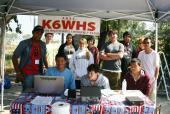 communications infrastructure.
communications infrastructure. Read more about their activities:
Wilson High Teen Applies Electronics/Ham Radio Skills to Assist City Disaster Communications
-
Ham Radio 101 at Granite Bay Montessori
Students roll up their sleeves to build their own tranceiver, antenna and explore robots too!
Learn More -
Should Learning Be This Much Fun?
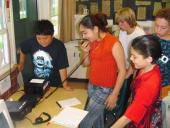 Students at Whitney Elementary explore ham radio. The verdict is: FUN!
Students at Whitney Elementary explore ham radio. The verdict is: FUN!
Learn More -
High Frequency Learning at Andover Middle School
"During the past five years, students in our Amateur Radio club and class have sent and received Morse code messages, assembled and soldered circuit boards, designed and built antenna systems, and used computer programs to analyze radio communications problems. They have also searched for hidden transmitters (called "fox hunts"), helped launch baHoons resembling weather balloons with a transmitter as a payload, and assisted in our county storm-spotting weather program."
Learn More -
NSTA Reports on the Benefits of Amateur Radio for Teaching Wireless Technology
The National Science Teachers Association journal investigated how teachers are using Amateur Radio as a springboard for teaching electronics and wireless technology. To read the article, click here (scroll down to the second half of the story).
Licensing, Education & Training >> Amateur Radio in the Classroom >> Classroom activities >> Articles and stories
